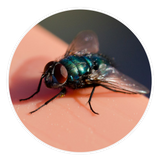 Warmer than usual temperatures are predicted for this summer and higher temperatures can be conducive for many pests including flies. Filth flies, like the common house fly, can develop very quickly under ideal summer temperatures. The developmental period can be as short as 7 days. Couple the short developmental time with a large reproductive potential (house fly females will lay 100-150 eggs); it is no wonder we are plagued with filth fly problems in the summer months. Filth fly populations generally peak in July and August in the Northern part of the U.S.
Warmer than usual temperatures are predicted for this summer and higher temperatures can be conducive for many pests including flies. Filth flies, like the common house fly, can develop very quickly under ideal summer temperatures. The developmental period can be as short as 7 days. Couple the short developmental time with a large reproductive potential (house fly females will lay 100-150 eggs); it is no wonder we are plagued with filth fly problems in the summer months. Filth fly populations generally peak in July and August in the Northern part of the U.S.
Unlike some of the small flies like fruit flies, most filth flies are not reproducing and breeding inside the facility. They are typically coming in from the exterior where they have laid their eggs in manure, garbage or other organic material. Filth flies, like the house fly and blow fly, will typically travel 1-2 miles but can travel 20 or more miles. With this large travel range, a food facility may not be able to eliminate all potential surrounding breeding sites. However, they can focus on eliminating breeding sites on their property, reduce fly attractants and be vigilant in fly exclusion methods. Some of the key areas to focus on include:
Reducing Attractants and Eliminating Breeding Sites on Property
Flies can be attracted to sites due to food odors. Areas of special concern from a filth fly standpoint include trash handling areas, exterior employee break areas and bulk unloading areas. Dumpster /compactors can be difficult to clean and maintain however, this will be the most common area for spillage and attraction for flies and other insects. Tips for proper dumpster design and maintenance include:
-
Keep refuse area as clean as possible to reduce it’s attractancy to pests. Place this area on a regular cleaning schedule and perform supervisory inspections to make sure that staff is cleaning the compactor pad, ledges on the exterior of the dumpster, and the area where the compactor/ dumpster unit connects. If employees must take out the garbage in bags to a remote dumpster, clean pavement areas leading from doors to dumpster. Sometimes, staff will drag garbage bags from the back door to dumpster, leaving a trail of organic debris. Grease and organic debris trails can attract flies, other insects and rodents to the building.
-
Insist upon a clean dumpster from your waste handler when units are changed. If the units are not switched, schedule a cleaning of the unit by your staff and the dumpster area when the refuse collector arrives.
-
Install unit on concrete pad free of cracks, where organic material may collect. Maintain the concrete and use sealants when necessary to repair cracks.
-
Keep facility doors leading to dumpster / compactor closed while not in use.
-
Make sure you have the right size dumpster for the amount of garbage discarded. Dumpster lids should be able to close. Garbage should be picked up more than once per week.
-
All exterior garbage cans should have self closing lids to discourage insect activity. This includes public garbage receptacles. These units should be checked and emptied daily. Wash the units at least weekly.
Additional areas where flies may be attracted to the site or breed include:
-
Exterior employee break areas where food scraps and containers may attract pests. Keep these areas as clean as possible.
-
Unloading areas for bulk products which are delivered by rail or trucks can be subject to spillage. Check these areas regularly and keep them as clean and free of food spills as possible.
-
Consider supplementing good sanitation with the use of fly control materials where appropriate. There are several good fly control baits on the market which can be used in stations or sprayed onto dumpster walls, dumpster lids and other areas where flies are congregating. Discuss these options with your pest management professional.
Exclusion
-
Keep doors closed when not in use. Employees should be instructed regarding the importance of keeping doors closed and the relationship to pest problems. Timers and/or alarms can also be helpful in reducing issues with doors being left open. Quick roll up doors can be helpful in limiting the movement of flies from dock areas to more sensitive areas in the plant like packaging and processing rooms.
-
Make sure doors and door seals are in good repair and maintained.
-
Check vents for proper filtering or screening to prevent pest entry.
-
Consider the use of air curtains on frequently used doors and drive-thru windows.
Should flies get past your exterior defenses, consider the use of insect light traps on the inside. These should be installed in areas where flies will be intercepted as they enter. Install low to the floor when possible and place where they will not attract flies towards open food. The bulbs to the insect light traps should not be visible from the outside since they may serve to attract insects towards the building.
How to Make Your Facility a No Fly Zone Pest Control and Exterminators in the Midwest
Serving...